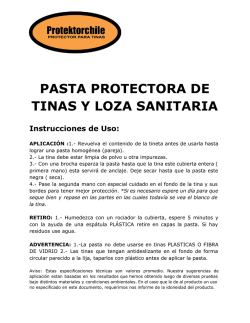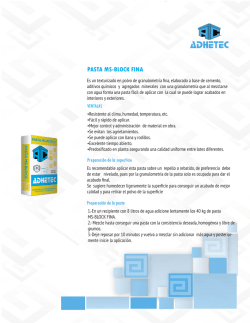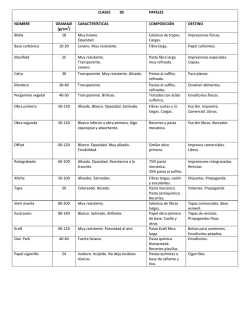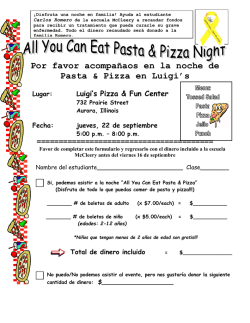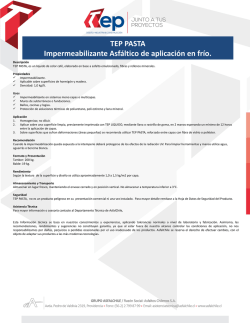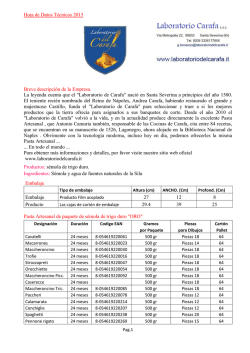
Pasta Extruder Attachment PE-50
INSTRUCTION BOOKLET AND RECIPES Pasta Extruder Attachment PE-50 For your safety and continued enjoyment of this product, always read the Instruction Book carefully before using. CONTENTS 5. The use of attachments not recommended or sold by Cuisinart may cause fire, electric shock or injury. Important Safeguards.................... 2 Special Cord Set Instructions ....... 3 Unpacking Instructions.................. 3 6. Do not use more than one attachment at a time. Parts and Features ........................ 4 Attaching to Stand Mixer ............... 5 7. Do not exceed the maximum capacities listed in this instruction booklet. Operation ....................................... 5 Cleaning and Maintenance ............ 6 8. Do not use the Stand Mixer or attachment if it is damaged or if the cord is damaged. Have it checked and serviced before resuming use. Tips and Hints .............................. 7 Recipes ......................................... 8 IMPORTANT SAFEGUARDS 10. Do not use outdoors. When using electrical appliances, basic safety precautions should always be taken, including the following: 11. To protect against the risk of electric shock, do not put the power base unit in water or other liquids. 9. Do not use this attachment for anything other than its intended use. 1. READ ALL INSTRUCTIONS BEFORE USING. 12. Do not let cord hang over edge of table or counter. 2. Turn dial to the OFF position and unplug the Cuisinart® Stand Mixer before fitting or removing the pasta extruder attachment, after use and before cleaning. 13. Never leave your pasta extruder attachment unattended while the Stand Mixer is running. 14. The attachments are intended for use with the basic appliance (SM-50). 3. Close supervision is necessary when any appliance is used by or near children. Cuisinart does not recommend the use of this appliance by children or individuals with certain disabilities. 15. Do not operate your appliance in an appliance garage or under a wall cabinet. When storing in an appliance garage always unplug the unit from the electrical outlet. Not doing so could create a risk of fire, especially if the appliance touches the walls of the garage or the door touches the unit as it closes. 4. NEVER FEED FOOD BY HAND; ALWAYS USE THE PUSHER. Avoid contact with moving parts and fitted attachments. To reduce the chances of bodily injury and/ or damage to the Stand Mixer or pasta extruder attachment, keep hands, clothing, cooking utensils, etc., away from the moving parts during operation. 2 SAVE THESE INSTRUCTIONS UNPACKING INSTRUCTIONS 1. Place the gift box containing your Cuisinart® Pasta Extruder Stand Mixer Attachment on a flat, sturdy surface before unpacking. FOR HOUSEHOLD USE ONLY 2. Lift the corrugated insert out of the gift box. Remove the body, wrench, and pasta plates. To assemble the pasta extruder attachment, follow Assembly Instructions on page 5. Replace all packaging materials inside box and save the box for repackaging. SPECIAL CORD SET INSTRUCTIONS Before using for the first time: Wash all parts according to Cleaning and Maintenance on page 6. A short power-supply cord is provided with the Stand Mixer to reduce the risks resulting from becoming entangled in or tripping over a longer cord. Longer extension cords are available and may be used if care is exercised in their use. If a long extension cord is used, the marked electrical rating of the extension cord must be at least as great as the electrical rating of the appliance, and the longer cord should be arranged so that it will not drape over the countertop or tabletop where it can be pulled on by children or tripped over. WARNING RISK OF FIRE OR ELECTRIC SHOCK DO NOT OPEN WARNING: TO REDUCE THE RISK OF FIRE OR ELECTRIC SHOCK, DO NOT REMOVE COVER (OR BACK) NO USER-SERVICEABLE PARTS INSIDE REPAIR SHOULD BE DONE BY AUTHORIZED SERVICE PERSONNEL ONLY 3 PARTS AND FEATURES 2 1. Body 2. Feed Tube 3. Feed Screw 1 4. Ring Nut 5. Wrench/Pusher/ Feed Screw Remover 6. Pasta Cutter Ring 4 7. Six Different Pasta Plates You can make the pasta of your choice. 3 7a. Pasta Plate for Spaghetti 7b. Pasta Plate for Small Macaroni 7c. Pasta Plate for Rigatoni 7d. Pasta Plate for Fusilli 7e. Pasta Plate for Bucatini 6 5 7f. Pasta Plate for Large Macaroni 8. Pasta Plate Storage Case 8 4 7a 7b 7c 7d 7e 7f ASSEMBLY INSTRUCTIONS plate, then follow assembly instructions 2 to 4 with the new pasta plate. Make sure there is no pasta dough obstructing the round groove located in the center of the feed screw. 1. Insert the feed screw, metal end first, into the front end of the pasta extruder body. Rotate until the plastic X on the feed screw lines up with the X-shaped groove inside the pasta extruder body. ATTACHING TO STAND MIXER 1. Make sure Stand Mixer is OFF. 2. Gently pull outlet cover off front of mixer head to remove. 3. Turn the Stand Mixer attachment knob counterclockwise until outlet opening is unobstructed. 2. Fit one of the pasta plates on top of the feed screw. Make sure that the notches on the four sides of the pasta plate slide securely onto the four grooves on the front end of the body. 4. Insert the assembled extruder attachment into the outlet opening, lining up the square metal hub on the extruder with the square indentation in the outlet opening. 3. Fit the ring nut over the pasta plate and turn it clockwise until it is secured to the body. 4. Attach the pasta cutter by sliding it over the ring nut and aligning the two notches on the side of the cutter with the two grooves on the pasta extruder body. Push in firmly, and while pushing firmly, turn the cutter clockwise to secure. It should move freely around the pasta plate and extruder body. 5. Turn the Stand Mixer attachment knob clockwise to secure to mixer. OPERATION 1. Prepare pasta dough as directed by recipe, letting it rest in the refrigerator until it is ready to be extruded. 2. Cut dough into 1-inch pieces. Cover with plastic wrap or a damp paper towel so it doesn’t dry out. 5. To switch the pasta plate, first remove the pasta cutter, then the ring nut and current pasta 5 3. Line a sheet tray with parchment paper and generously dust with semolina flour to keep pasta from sticking. Set sheet below extruder attachment. generously dusted with semolina flour, dried and stored in airtight bags in the refrigerator. 8. Boil pasta in generously salted water to desired doneness. Recommended cooking time is about 3 minutes for spaghetti and 6 minutes for al dente rigatoni, though cooking times vary (see Tips and Hints section). 4. Set Stand Mixer to Speed 5 and slowly drop in 4 pieces of dough, one at a time, without using the pusher (if making spaghetti or bucatini, use Speed 10). Do not overfill. NOTE: Dough will “knead” in the extruder chute for about 1 minute, before extrusion begins. CLEANING AND MAINTENANCE 1. Remove the pasta cutter manually by pushing it firmly and rotating it counterclockwise to release the notches from the grooves on the pasta extruder body. Then remove the ring nut manually or with the wrench if it is fastened too tightly. 5. When extruded pasta reaches desired length, use the pasta cutter ring to cut it, by turning the cutter first to the left and then quickly to the right; let cut pasta fall onto dusted sheet tray. If pasta dough sticks to the back of the cutter this may lead to unclean cuts. If this is the case first stop the unit, remove the pasta cutter ring and clean out any stuck dough. Replace cutter ring and continue with remaining dough. If this continues to occur dough may be too soft. To prevent this from occurring dust each piece of dough in “00” flour before putting through the extruder. 2. Feed screw can be removed by using the hook on the top of the wrench/pusher. Please note: the feed screw metal washers may be very hot. Let cool before touching. 6. Drop in more dough pieces, one at a time, as pasta is extruded and cut. Generously dust all cut pasta with more semolina flour. 3. Allow dough on the pasta plates to dry before cleaning. Once dough is dry, separate the plastic and metal pieces of the pasta plates and gently tap out any loose dough. To remove stubborn dry dough, using a wooden or plastic skewer, or toothpick, is help- 7. Repeat extrusion and cutting process with remaining dough pieces. NOTE: Pasta can be cooked immediately or 6 ful. Do not use metal tools to scrape off dough or you may cause damage to the plates. The pasta plate pieces are marked for easy assembly. F = Fusilli B = Bucatini R = Rigatoni LM = Large Macaroni SM = Small Macaroni S = Spaghetti and feel the dough when you are finished kneading. If it is still sticky, knead in one tablespoon of flour at a time until the stickiness disappears. • Always add pasta dough to feed tube slowly, waiting a couple of minutes for it to knead in the chute and begin extruding before adding more. Do not overfill, which will cause pasta to extrude very slowly. • If pasta extrudes too slowly, turn off the Stand Mixer and carefully remove some dough from the pasta extruder chute. 4. Do not wash pasta extruder housing in dishwasher or immerse in water or other liquids. Wipe extruder with damp cloth. Wash ring nut in warm, soapy water. Do not put the ring nut or pasta plates in the dishwasher. Pasta plates can be washed in warm, soapy water and are top-rack dishwasher safe. • If a piece of pasta gets stuck, turn off the Stand Mixer and gently nudge lodged dough piece with the back of the wrench. • A pasta cutter is included to cut pasta, but a paring knife or metal bench scraper can also be used. • Try to cut pasta into similar lengths to ensure even cooking. 5. Any other servicing should be performed by an authorized service representative. • The dough may come out curly in the first batch. The dough should straighten in the second batch. Any curled pasta can be reprocessed. Tips and Hints • It is essential to stir the flour before you measure it. Do not scoop it right out of the bag. • Separate pasta as soon as it is cut from the pasta extruder. Toss freshly extruded pasta with semolina flour to prevent sticking. Pile dusted noodles together in loose bundles on a flat, clean surface. • The key to making fresh pasta is to have the right feel of the dough – not too moist or too dry. Dough should be pliable and come together in one ball, yet should not be sticky to the touch. • To cook pasta, add 1 tablespoon of salt and 1 tablespoon of oil to 6 quarts boiling water. Add pasta slowly and sepa- • The humidity of the day can greatly affect the pasta dough. If the day is very humid, watch 7 Recipes rately; make sure no pasta is sticking together before adding to water. Cook as directed, stirring occasionally. Drain in colander. Basic Pasta Dough The combination of “00” and semolina flour gives this dough the perfect bite when cooked, compared to traditional pasta dough made with just semolina flour. • Fresh pasta is best if cooked immediately. Store up to 5 days in the refrigerator, first air-drying for one hour, then sealing in plastic bag. • Generously dusted fresh pasta can be “dried” to achieve a texture more similar to dried, boxed pasta. Simply let it sit at room temperature for up to 4 hours before storing. Makes about 1 pound; 4 to 5 servings 5 2½ • Fresh pasta cooks much faster than dried, boxed pasta, but cooking times will vary based on size and thickness of any pasta. As you work with your homemade pastas, you will learn the timing that works best. /3 2 large eggs cups “00” flour, plus more as needed for kneading cup semolina flour 1. Put all of the ingredients, in the order listed, into the Cuisinart® mixing bowl. Attach the dough hook and mix on Speed 5 to combine, about 1 minute. • The Stand Mixer should rest at least one hour after processing 2 pasta dough recipes. 2. Continue mixing until dough mostly comes together, an additional 4 to 6 minutes. At about 5 minutes of mixing, check the texture. If it is too dry, add water one tablespoon at a time; alternatively, if it is too wet, add the “00” flour one tablespoon at a time to desired consistency. Keep in mind, this dough will not resemble a smooth ball; it will only just come together in large chunks with some possible smaller bits to knead in by hand. Should any flour or loose dry bits be left behind at the bottom of the bowl, leave them there and do not • Generously dust pasta with semolina flour after extruding to prevent sticking. Excess flour will fall off during cooking. 8 MANUAL DE INSTRUCCIONES/ LIBRO DE RECETAS Aditamento extrusor de pasta Para su seguridad y para disfrutar plenamente de este producto, siempre lea cuidadosamente las instrucciones antes de usarlo. PE-50 ÍNDICE la ropa y los utensilios alejados de las piezas móviles durante el funcionamiento. Medidas de seguridad importantes.. 2 Uso de extensiones ........................ 3 5. El uso de accesorios/ aditamentos no recomendados o vendidos por Cuisinart presenta un riesgo de incendio, electrocución o heridas. Instrucciones de desembalaje..... .. 3 Piezas y características .................. 4 Conexión a la batidora de pie ........ 5 Operación ....................................... 6 6. No use más de un aditamento a la vez. Limpieza y mantenimiento ............. 7 Consejos y sugerencias ................. 7 Recetas ......................................... 9 7. No exceda las capacidades máximas indicadas en este manual de instrucciones. MEDIDAS DE SEGURIDAD IMPORTANTES 8. No utilice el aparato ni el aditamento si estuvieran dañados o si el cable estuviera dañado; regréselos a un centro de servicio autorizado para que los revisen y los reparen. 9. No utilice este aditamento para ningún otro fin que no sea el indicado. Al usar aparatos eléctricos, siempre debe tomar precauciones básicas de seguridad, incluso las siguientes: 10. No lo utilice en exteriores. 1. LEA TODAS LAS INSTRUCCIONES ANTES DE USARLO. 11. Para reducir el riesgo de electrocución, no coloque la base del aparato en agua ni en ningún otro líquido. 2. Apague (“OFF”) y desconecte la batidora de pie Cuisinart® antes de instalar/retirar el aditamento extrusor de pasta, después del uso y antes de la limpieza. 12. No permita que el cable cuelgue del borde de la mesa o de la encimera. 13. Nunca descuide/deje sin vigilancia el aditamento mientras la batidora de mano está funcionando. 3. Supervise el uso de este aparato cuidadosamente cuando sea usado por o cerca de niños. Cuisinart no recomienda que los niños o personas con ciertas discapacidades usen este aparato. 14. Este accesorio ha sido diseñado para ser usado con la batidora de pie Cuisinart SM-50. 15. No haga funcionar el aparato debajo o dentro de un armario/ gabinete. Siempre desconecte el aparato antes de guardarlo en un armario/gabinete. Dejar el aparato conectado presenta un riesgo de incendio, especialmente si este toca las paredes o la puerta del armario/ gabinete cuando cierra. 4. NUNCA INTRODUZCA LA MANO EN LA BOCA DE ALIMENTACIÓN; SIEMPRE USE EL EMPUJADOR. Evite el contacto con las piezas móviles y los accesorios/aditamentos. Para evitar el riesgo de heridas y/o daños al aparato o al aditamento, mantenga las manos, el cabello, 2 GUARDE ESTAS INSTRUCCIONES INSTRUCCIONES DE DESEMBALAJE PARA USO DOMÉSTICO SOLAMENTE 2. Retire el inserto de cartón de la caja. Retire el cuerpo del aditamento, la llave y las rejillas para hace pasta. 1. Ponga la caja sobre una superficie espaciosa, plana y segura. Para ensamblar el aditamento extrusor de pasta, siga las instrucciones de ensamblaje que se encuentran en la página 5. Le aconsejamos que conserve el material de embalaje. USO DE EXTENSIONES Antes del primer uso: Lave todas las piezas, según se describe en la sección “Limpieza y Mantenimiento” en la página 7. El cable provisto con la batidora de pie es corto, para reducir el peligro de que alguien se enganche o tropiece con un cable más largo. Se podrá usar una extensión eléctrica, pero con cuidado. La clasificación nominal de la extensión debe ser por lo menos igual a la del aparato. Es importante acomodar el cable más largo de manera que no cuelgue de la encimera/mesa donde puede ser jalado por niños o puede causar tropiezos. ADVERTENCIA RIESGO DE INCENDIO O ELECTROCUCIÓN NO LO ABRA ADVERTENCIA: PARA REDUCIR EL RIESGO DE ELECTROCUCIÓN, NO DESARME EL CUERPO DEL APARATO. ESTE APARATO NO CONTIENE NINGUNA PIEZA QUE PUEDA SER REPARADA/CAMBIADA POR EL USUARIO. LAS REPARACIONES DEBEN SER EFECTUADAS POR TÉCNICOS AUTORIZADOS SOLAMENTE. 3 PIEZAS Y CARACTERÍSTICAS 2 1. Cuerpo 2. Boca de llenado 3. Tornillo de alimentación 1 4. Tuerca de sujeción 5. Llave/Empujador/ Herramienta para quitar el tornillo de alimentación 6. Aro cortador de pasta 4 3 7. Seis rejillas para pasta Para hacer la pasta de su elección. 7a. Rejilla n.° 1 para espaguetis 7b. Rejilla n.° 2 para macarrones/ coditos pequeños 7c. Rejilla n.° 3 para pasta rigatoni 7d. Rejilla n.° 4 para pasta fusilli 7e. Rejilla n.° 5 para pasta bucatini 6 5 7f. Rejilla n.° 6 para macarrones/ coditos grandes 8. Caja de almacenaje de las rejillas para hacer pasta 8 4 7a 7b 7c 7d 7e 7f INSTRUCCIONES DE ENSAMBLAJE presione, gire el aro cortador en sentido horario para sujetarlo. El aro cortador debe mover libremente alrededor de la rejilla para hacer pasta y del cuerpo del extrusor. 1. Introduzca el tornillo de alimentación, el lado metálico largo primero, en la abertura en el cuerpo del extrusor. Gire hasta que la X de plástico sobre el tornillo de alimentación coincida con la hendidura en forma de X adentro del cuerpo del extrusor. 5. Para cambiar la rejilla, retire primero el aro cortador. Luego, quite la tuerca de sujeción y la rejilla, e instale la nueva rejilla, siguiendo los pasos 2–4 más arriba. Cerciórese de que no haya masa en la ranura redonda ubicada en el centro del tornillo de alimentación. CONEXIÓN A LA BATIDORA DE PIE 2. Instale la rejilla deseada sobre la punta del tornillo de alimentación. Cerciórese de que las muescas en los cuatro lados de la rejilla encajen de manera segura con las cuatro ranuras en la parte delantera del cuerpo. 1. Asegúrese de que la batidora esté apagada (“OFF”). 2. Quite suavemente la tapa del receptáculo para aditamentos. 3. Afloje la perilla para aditamentos de la batidora de pie, girando en sentido antihorario hasta que el puerto de conexión se abra. 3. Coloque la tuerca de sujeción sobre la rejilla y gírela en sentido horario para sujetarla. 4. Introduzca el eje cuadrado del aditamento en el puerto de conexión. De ser necesario, gire el aditamento ligeramente hacia la derecha de manera que la pequeña clavija sobre el aditamento se encuentre a la derecha de la abertura. Gire 4. Conecte el aro cortador de pasta, deslizándolo por encima de la tuerca de sujeción y alineando las dos muescas en el costado del cortadora con las dos ranuras en el cuerpo del extrusor. Presione firmemente, y mientras 5 rápidamente hacia la derecha, para cortarla; deje que la pasta caiga sobre la placa enharinada. Si la masa empieza a pegar a la parte trasera del aro cortador, puede que el corte no sea limpio. Si esto ocurriera, apague la unidad, retire el aro cortador y límpielo. Vuelva a instalar el aro cortador y continúe con la masa restante. Si el problema sigue ocurriendo, puede que la masa esté demasiado suave. Para solucionar este problema, enharine cada pedazo de masa con harina “00” antes de colocarlo en el extrusor. ligeramente el aditamento hacia adelante y atrás de manera que la clavija en el eje del aditamento encaje en la ranura del receptáculo. 5. Apriete la perilla para aditamentos de la batidora de pie, girando en sentido horario, para sujetar el aditamento a la batidora. OPERACIÓN 1. Prepare la masa de pasta según la receta, dejándola reposar hasta que esté lista para ser extrudida. 2. Corte la masa en pedazos de 1 pulgada (2.5 cm). Cubra la masa con papel film/plástico o una toalla húmeda para evitar que se seque. 6. Eche la masa en la boca de alimentación un pedazo a la vez, y corte la pasta a medida que sale del extrusor. Espolvoree generosamente la pasta cortada con sémola. 3. Forre una placa para horno con papel sulfurizado y enharínela generosamente con sémola (para evitar que la pasta se pegue a la placa). Ubique la placa bajo la boca de salida del extrusor. 7. Repita el proceso con la masa restante. NOTA: puede cocinar la pasta inmediatamente o espolvorearla generosamente con sémola y secarla, y luego refrigerarla en bolsas herméticas. 4. Encienda la batidora a la velocidad 5 (si está haciendo espagueti o pasta bucatini, utilice la velocidad 10) y eche lentamente 4 pedazos de masa, uno a la vez, en la boca de alimentación. No use el empujador. No sobrellene el depósito. NOTA: la masa “se amasará” en el cuerpo del extrusor por aproximadamente 1 minuto antes de salir por la rejilla. 8. Cocine la pasta hasta el punto deseado, en agua generosamente salada. Para que estén “al dente”, se recomienda cocinar los espaguetis por 3 minutos y la pasta rigatoni por 6 minutos, pero el tiempo de cocción puede variar (véase la sección “Consejos y sugerencias”). 5. Cuando la pasta tenga la longitud deseada, gire el aro cortador primero hacia la izquierda, y luego 6 LIMPIEZA Y MANTENIMIENTO F = Fusilli B = Bucatini R = Rigatoni LM = Macarrones/coditos grandes SM = Macarrones/coditos pequeños S = Espagueti 1. Retire manualmente el cortador de pasta, girándolo en sentido antihorario para liberar las muescas de las hendiduras sobre el cuerpo del extrusor. Luego, afloje la tuerca de sujeción manualmente o con la llave provista para retirarla. 2. Nota: utilice el gancho arriba de la llave/empujador para retirar el tornillo de alimentación. Las tuercas metálicas del tornillo de alimentación pueden ponerse muy calientes; permita que se enfríen antes de tocarlo. 4. No meta el cuerpo del extrusor de pasta al lavavajillas ni lo sumerja en agua u otro líquido. Limpie el extrusor con un paño húmedo. Lave la tuerca de sujeción a mano en agua jabonosa tibia. Nota: la tuerca de sujeción NO es apta para lavavajillas. Las rejillas para hace pasta pueden lavarse a mano, con detergente y agua tibia, o en el nivel superior del lavavajillas. 5. Cualquier otro servicio debe ser realizado por un técnico autorizado. 3. Permita que los residuos de masa sobre las rejillas se sequen antes de limpiar estas. Cuando la masa esté seca, separe la pieza de plástico de la de metal y de golpecitos para quitar los residuos. Puede resultar útil usar un pincho (o un palillo) de madera o de plástico para quitar los residuos difíciles. No utilice herramientas de metal para raspar la masa; esto puede dañar las rejillas. Las rejillas para hacer pasta están marcadas con letras para una fácil identificación. Consejos y sugerencias • Es imprescindible revolver la harina antes de medirla. No mida la harina directamente al salir del paquete. • El secreto de la pasta fresca es la consistencia de la masa – no muy húmeda ni muy seca. La masa debe estar flexible y formar una bola de masa, pero no pegajosa al tacto. • La humedad del aire puede afectar significativamente el resultado. Si el día es 7 peguen. Haga pilas sueltas de pastas sobre una superficie plana y limpia. muy húmedo, averigüe la consistencia de la masa inmediatamente después de amasarla. Si la masa está pegajosa, agregue harina, una cuchara a la vez, y siga amasando hasta que esté suave. • Para cocinar la pasta, caliente 6 cuartos de galón (5.7 L) de agua; agregue 1 cucharada de sal y 1 cucharada de aceite. Agregue las pastas lentamente y por separado, cerciorándose de que no estén pegadas antes de introducirlas en el agua. Cocínelas según las instrucciones, revolviendo ocasionalmente. Escurra con un colador. • Siempre alimente el extrusor lentamente, esperando un par de minutos hasta que la pasta salga del extrusor antes de echar más masa en la boca de alimentación. No sobrellene la boca de alimentación; esto ralentizará el extrusor. • La pasta fresca es mejor si se cocina inmediatamente, pero se conservará durante hasta 5 días en el refrigerador, siempre que la seque primero por una hora, y luego la guarde en una bolsa hermética. • Si el extrusor ralentiza, apague el aparato y retire cuidadosamente un poco de masa de la boca de alimentación. • Si un pedazo de masa se queda atascado en el extrusor, apague la batidora de pie y empuje suavemente el pedazo de masa con la llave. • Para que la pasta adquiera una textura similar a la textura de la pasta seca vendida en cajas, enharínela generosamente y permita que se seque a temperatura ambiente durante hasta 4 horas. • El aditamento extrusor incluye un cortador de pasta, pero también puede usar un cuchillo o un raspador de masa para cortar la pasta. • Por lo general, la pasta fresca se cocina mucho más rápido que la pasta seca en caja, pero el tiempo de cocción puede variar según el tamaño y el espesor de la pasta. La experiencia le enseñará cuanto tiempo cocinar cada tipo de pasta casera. • Procure cortar la pasta a la misma longitud para asegurar una cocción uniforme. • Puede que la primera tanda de pasta salga “rizada” del extrusor. La tanda siguiente se enderezará. Puede volver a procesar la pasta “rizada” si desea. • Permita que la batidora descanse por una o más hora antes de procesar tandas consecutivas. • Separe las pastas inmediatamente después de cortarlas y espolvoréelas con sémola para evitar que se • Espolvoree generosamente las pastas con sémola para evitar que se peguen. El exceso de 8 Recetas sémola se caerá durante la cocción. Pasta básica La combinación de harina “00” y de sémola da a la pasta cocida la consistencia perfecta. Rinde aproximadamente 4–5 porciones; 1 libra (455 g) de masa 5 2½ /3 2 2 huevos grandes tazas (300 g) de harina “00” + un poco más de ser necesario para amasar taza (160 ml) de agua tazas (330 g) de sémola 1. Colocar todos los ingredientes en el bol de la batidora, en el orden indicado. Instalar el gancho amasador y revolver a velocidad 5 por aproximadamente 1 minuto. 2. Seguir amasando por 4–6 minutos, hasta que la masa llegue a formar una bola. Averiguar la textura de la masa después de 5 minutos. Si la masa está demasiado seca, agregar agua, una cucharada a la vez, hasta conseguir la consistencia deseada. Si está demasiado húmeda, agregar harina “00”, una cucharada a la vez, hasta conseguir la consistencia deseada. Tener presente que la masa no formará una bolsa suave, sino pedazos grandes con pedacitos más pequeños que deberá terminar de amasar a mano. Si queda harina o pedacitos secos de 9
© Copyright 2025
